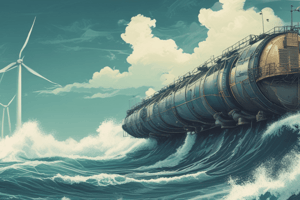Podcast
Questions and Answers
What is a tide?
What is a tide?
The periodic rise and fall of the oceans and other large bodies of water.
What is tidal range?
What is tidal range?
The difference in levels of ocean water at high tide and low tide.
What is a spring tide?
What is a spring tide?
A tide with the greatest difference between high and low tide that occurs when the sun and the moon are aligned with Earth at the new moon and full moon.
What is a neap tide?
What is a neap tide?
During a neap tide, there is the LEAST difference between high and low tides. ______s occur during the first and third quarters of the moon.
During a neap tide, there is the LEAST difference between high and low tides. ______s occur during the first and third quarters of the moon.
During a spring tide, the GREATEST differences between the tides occur. ______s occur during new and full moons.
During a spring tide, the GREATEST differences between the tides occur. ______s occur during new and full moons.
A narrow inlet of land along a coast is where you might see a _________. This causes a very sudden rise in the tide.
A narrow inlet of land along a coast is where you might see a _________. This causes a very sudden rise in the tide.
Neap, spring, high, and low are all types of __________.
Neap, spring, high, and low are all types of __________.
The difference between levels of ocean water at high tide and low tide is called a(n) __________.
The difference between levels of ocean water at high tide and low tide is called a(n) __________.
On what type of coast would a tidal bore most likely occur?
On what type of coast would a tidal bore most likely occur?
Explain how the positions of the Earth, moon, and sun affect the tides.
Explain how the positions of the Earth, moon, and sun affect the tides.
On what kind of coastline would you predict the largest tidal ranges to occur?
On what kind of coastline would you predict the largest tidal ranges to occur?
The most important force that creates tides is the gravity of the __________.
The most important force that creates tides is the gravity of the __________.
What is a tidal bulge?
What is a tidal bulge?
Low tide forms when water is drawn away from the area between high tides.
Low tide forms when water is drawn away from the area between high tides.
An unusually high tide is called a __________ tide.
An unusually high tide is called a __________ tide.
Which of these takes exactly 24 hours?
Which of these takes exactly 24 hours?
The difference between water levels at low and high tide is called __________.
The difference between water levels at low and high tide is called __________.
When do the greatest tidal ranges occur?
When do the greatest tidal ranges occur?
Tides that occur during the first and third quarters of the moon are called __________.
Tides that occur during the first and third quarters of the moon are called __________.
Which statement describes what is happening at high tide?
Which statement describes what is happening at high tide?
A bulge that takes place on parts of Earth facing or opposite the moon is called __________.
A bulge that takes place on parts of Earth facing or opposite the moon is called __________.
From what is known about spring tides and neap tides, you can conclude that
From what is known about spring tides and neap tides, you can conclude that
How often do tides rise and fall?
How often do tides rise and fall?
Flashcards are hidden until you start studying
Study Notes
Tides Overview
- Tides are the periodic rise and fall of oceans and large bodies of water.
- The force of gravity from the moon largely influences tide movement.
Tidal Range
- Tidal range refers to the difference between high tide and low tide levels.
Types of Tides
- Spring Tide:
- Occurs during new and full moons.
- Characterized by the greatest difference between high and low tides due to alignment of the sun, moon, and Earth.
- Neap Tide:
- Happens during the first and third quarters of the moon.
- Exhibits the least difference between high and low tides because the sun and moon exert gravitational forces at right angles to each other.
Tidal Phenomena
- Tidal Bore:
- A sudden rise in tide observed in narrow inlets or river channels, where the leading edge of incoming tide forms a wave.
- Tidal Bulge:
- A bulge created in ocean waters on both the side facing the moon and the opposite side.
Coastline Characteristics
- Largest tidal ranges typically occur along coastlines with long narrow inlets or basins.
- Tidal bores are expected in areas with narrow bays, inlets, and river channels.
Tidal Patterns
- Tides generally rise and fall twice a day.
- Tidal heights vary with the lunar cycle; spring tides have greater heights and neap tides have lower heights.
Gravity and Tides
- The primary force responsible for tides is the gravity of the moon.
- The positioning of the Earth, moon, and sun determines tidal movements:
- During spring tides, gravitational forces are aligned, enhancing tidal effects.
- During neap tides, gravitational forces counteract each other, reducing tidal effects.
High and Low Tides
- High tide is characterized by ocean water bulging towards the moon, while low tide occurs when water is drawn away from the coastal area.
- High tides and low tides vary based on lunar phases and gravitational influences.
Tidal Timing
- One rotation of the Earth takes approximately 24 hours, influencing the timing of high and low tides.
- The height of the tides fluctuates with the lunar phases, resulting in predictable tidal patterns.
Studying That Suits You
Use AI to generate personalized quizzes and flashcards to suit your learning preferences.





